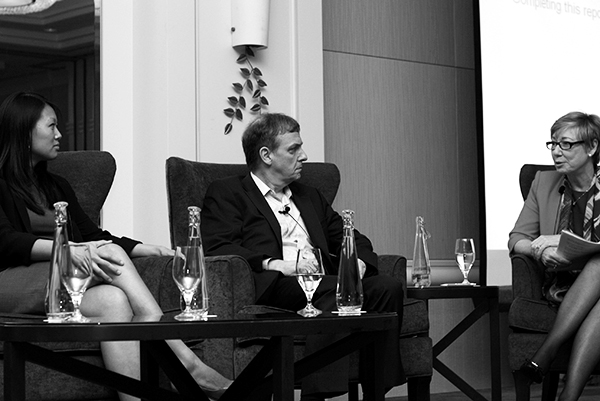The Minerva Foundation for BC Women hosted its Changing the Face of Leadership Conference on Friday, May 3, where more than 225 men and women from across British Columbia and beyond gathered to discuss values-based leadership and important issues and challenges facing today’s leaders.
Opening the conference was the presentation of preliminary findings from the Minerva Foundation’s Face of Leadership study, the first comprehensive analysis of the gender breakdown at the top leadership levels across British Columbia’s largest industries.
The preliminary findings reveal that while women make up 50.4 per cent of the British Columbian population, just 20 per cent of businesses are run by them. Industries with more than 25 per cent women leaders include non-profit groups (67 per cent), retailers (58 per cent) and the federal government (53 per cent). Industries with no women leaders include crown corporations, engineering firms and restaurant chains.
Changing the Face of Leadership in BC
The Face of Leadership study, which is being conducted on behalf of the Minerva Foundation by Board Director, Robert Elton (former CEO of BC Hydro), along with a team of volunteer researchers, is a starting point for the organization to realize its vision to change the face of leadership in BC.
“Any meaningful change starts with an honest look at your starting point,” says Minerva Foundation CEO, Fiona Douglas-Crampton. “It is important to shine a light on the facts and identify whether women are in the decision-making roles across the province.”
Based on the representation of women leaders, the researchers divided BC industries into three tiers. The first tier, with more than 25 per cent women leaders, represents industries with the most women in leadership positions, while the second tier represents industries with between 10 per cent and 25 per cent women leaders and the third tier represents industries with less than 10 per cent women leaders.
Key Trends Observed
“Among the trends that stood out to us,” says researcher Jennifer Sung, “is that the industries with the most female leaders are what might typically be referred to as ‘feminine industries’, like retail and non-profit, while other industries represented in this tier have specific policies in place to promote women”.
Another observation highlighted by the research team is that the province’s largest industries – and its key economic drivers – can mostly be found in the third tier, where less than 10 per cent of firms are led by women. These include mining, technology, crown corporations, engineering and finance, among others.
“One of the most interesting observations is the question of economic drivers,” says Douglas-Crampton. “When we look at women in leadership roles we have to qualify the numbers with the impact of those roles. These findings indicate that the province’s most powerful industries are still mostly led by men.”
The absence of women from the province’s top leadership positions is echoed at the national level, as reported in Carlton University’s 2012 study, Progress in Inches, Miles to Go, which found that Canadian women hold just 29 per cent of senior management positions, though they constitute 47 per cent of the labour force. According to the report’s authors, women’s absence from the country’s top positions is more than an issue of adequate supply, as women experience under-representation in senior leadership even in sectors in which the make up a “significant percentage of middle managers and specialized managers.”
Another trend noted by the Face of Leadership researchers, says Sung, is that industries with the lowest numbers of female leadership often have equal gender representation at the university-level. This is also true country-wide, as researchers from the Progress in Inches study also described the under-representation of women leaders in fields where they “dominate” in terms of educational credentials.
“You graduate from this type of [gender equality] bubble in university and you find that changes very quickly when you get into the workforce,” says Sung.
Closing the Gender Gap
For Douglas-Crampton, supporting women on their leadership journey is key to closing the gender gap, as is engaging men in the conversation and encouraging all people to lead from their values.
“It’s not just about getting more women into leadership roles, though that is essential to achieving gender equality,” says Douglas-Crampton. “But we also need to move away from the old command and control model of leadership to one that is values based—something that we believe will create more equitable workplaces for men and women, and more meaningful connections to our work in business and our community.”
For the Minerva Foundation, this first step in analyzing the landscape of BC leadership is fundamental to realizing the organization’s vision and creating meaningful change. As the Face of Leadership study progresses with interviews and recommendations, the Minerva Foundation will continue to support BC women to develop their leadership capacity and find meaningful work through its leadership development programs, employment programs and education awards.



